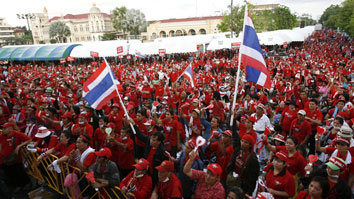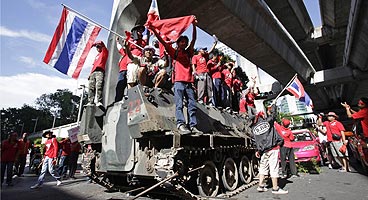|
El
conflicto es una lucha de clases creciente entre los pobres
y las viejas élites del país
Los
"camisas rojas" luchan por
una verdadera
democracia
Por
Giles Ji Ungpakorn (*)
The Guardian,
13/04/09
Rebelión,
15/04/09
Traducción
de María Enguix
|

|
|
Los “camisas rojas” agrupan a los sectores más
pobres
|
El
conflicto en Tailandia no es un juego de simples filiaciones
políticas: es una lucha de clases creciente entre los
pobres y las viejas élites del país.
Quienes
hayan visto la violencia de esta semana en las calles de
Bangkok, seguramente pensarán que el caos actual es sólo
cosa de camisas de colores diferentes y de partidarios de
diferentes partidos políticos, apenas distinguibles entre sí.
No es el caso.
Lo
que llevamos viendo en Tailandia desde finales de 2005 es
una lucha de clases creciente entre los pobres y las viejas
élites. Desde luego no es una lucha de clases en sentido
estricto. Como en el pasado hubo un vacío en la izquierda,
los políticos millonarios y populistas como Thaksin
Shinawatra han logrado liderar a los pobres.
Los
pobres, urbanos y rurales, que forman la mayoría del
electorado, son los «camisas rojas». Exigen su derecho a
tener un gobierno elegido democráticamente. Comenzaron como
partidarios pasivos del gobierno de Thaksin, el Thai Rak
Thai, pero luego formaron un nuevo movimiento ciudadano
llamado Democracia Real.
Para
ellos, la democracia real significa el final de la dictadura
de la junta militar y palaciega, aceptada desde hace tiempo
calladamente y que ha permitido a los generales, los
consejeros áulicos del consejo privado y las élites
conservadoras actuar al margen de la Constitución. Desde
2006, estas élites han atentado descaradamente contra los
resultados electorales gracias a un golpe militar, el uso de
los tribunales para disolver el partido de Thaksin en dos
ocasiones y el respaldo a la violencia callejera de los «camisas
amarillas» monárquicos.
El
partido Demócrata actual está en el gobierno gracias al ejército.
Muchos miembros del movimiento de los camisas rojas apoyan a
Thaksin, y por buenas razones: su gobierno despuntó por
varias políticas modernas en beneficio de los pobres, como
la creación del primer sistema sanitario universal de
Tailandia.
No
obstante, los «camisas rojas» no son simples títeres de
Thaksin; están organizados en grupos comunitarios y muchos
de ellos muestran su frustración por la falta de liderazgo
progresista de Thaksin, en particular por su insistencia en
la «lealtad» a la corona.
|

|
|
Camisas rojas se apoderan de un tanque
|
El
movimiento republicano está creciendo. Muchos izquierdistas
tailandeses, como es mi caso, no apoyan a Thaksin.
Denunciamos sus violaciones de los derechos humanos, pero
estamos con el movimiento ciudadano por la democracia real.
Los
«camisas amarillas» son conservadores monárquicos,
algunos con tendencias fascistas. Sus guardias llevan y usan
armas de fuego. Apoyaron el golpe de Estado de 2006,
destrozaron el palacio del gobierno y bloquearon los
aeropuertos internacionales el año pasado. Estaban
respaldados por el ejército. Por eso los soldados nunca
disparan contra ellos. Por eso el primer ministro tailandés
actual educado en Oxford nunca ha hecho nada por
castigarlos. A fin de cuentas, nombró a algunos de ellos
ministros de Estado.
Los
«camisas amarillas» pretenden menoscabar el derecho de
voto del electorado para proteger a las élites
conservadoras y los «viejos y malos usos» para gobernar
Tailandia. Proponen un «nuevo orden» dictatorial, que
permita al pueblo votar, pero no que parlamentarios y cargos
públicos se presenten en su mayoría a las elecciones.
Reciben el apoyo de los medios de comunicación tailandeses
convencionales, de la mayor parte de los profesores de clase
media e incluso de dirigentes de oenegés.
Para
comprender y juzgar los violentos sucesos que sacuden
Tailandia, es preciso tener un conocimiento y una
perspectiva de la historia del país. La perspectiva es
necesaria para poder distinguir entre atentar contra la
propiedad y herir o matar a la gente.
El
conocimiento histórico ayuda a explicar por qué los
ciudadanos conocidos como «camisas rojas» expresan ahora
su furia. Han tenido que soportar el azote militar, la
privación reiterada de sus derechos democráticos,
continuos actos de violencia e insultos por parte de los
medios de comunicación convencionales
y de la comunidad académica.
Es
mucho lo que está en juego. Todo compromiso está expuesto
a la inestabilidad. Las viejas élites quizá piensen
negociar con Thaksin para impedir que los camisas rojas se
vuelvan completamente republicanos. Pero, pase lo que pase,
la sociedad tailandesa no puede volver a los tiempos
pasados. Los «camisas rojas» representan a millones de
tailandeses hastiados de las intervenciones militares y monárquicas
en la vida política. Como mínimo desearán una monarquía
constitucional no política.
(*)
Giles Ji Ungpakorn es profesor y escritor tailandés que
viajó en febrero al Reino Unido tras ser acusado de lesa
majestad en virtud del código penal, que prohíbe este tipo
de críticas.
Red
Shirts in Thailand face the armed might of
the ruling elites
Giles
Ji Ungpakorn
WDPress
(wdpress.blog.co.uk), 13/04/09
For
the fourth time in forty years, troops have opened fire on
pro–democracy demonstrators in Bangkok. Each time the aim
has been the same: to protect the interests of the
Conservative Elites who have run Thailand for the past 70
years.
For
those watching the cold–blooded murder by soldiers on the
streets of Bangkok, it may be tempting just to assume that
the present chaos is merely about different coloured T
shirts and supporters of different political parties, as
though they were mirror images of each other. This is not
the case.
What
we have been seeing in Thailand since late 2005, is a
growing class war between the poor and the old elites. It is
of course not a pure class war. Due to a vacuum on the Left
in the past, millionaire and populist politicians like
Taksin Shinawat have managed to provide leadership to the
poor. The urban and rural poor, who form the majority of the
electorate, are the Red Shirts. They want the right to
choose their own democratically elected government. They
started out as passive supporters of Thaksin’s Thai Rak
Thai government. But they have now formed a brand new
citizens’ movement for what they call “Real Democracy”.
For them, “Real Democracy” means an end to the long–accepted
“Quiet Dictatorship” of the Army generals and the Palace.
This situation allowed the generals, the King’s advisors
in the Privy Council and the conservative elites to act as
though they were above the Constitution. Les majeste laws
and intermittent repression have been used to silence
opposition. Ever since 2006, these elites have blatantly
acted against election results by staging a military coup,
using the courts to twice dissolve Taksin’s party and by
backing Yellow Shirt Royalist mob violence on the streets.
The present mis–named Democrat Party government was
manoeuvred into place by the Army.
Most
of those in the Red Shirt movement support Taksin for good
reasons. His government put in place many modern pro–poor
policies, including Thailand’s first ever universal health
care system. Yet the Red Shirts are not merely Taksin
puppets. There is a dialectical relationship between Taksin
and the Red Shirts. His leadership provides encouragement
and confidence to fight. Yet the Red Shirts are self–organised
in community groups and some are showing frustration with
Taksin’s lack of progressive leadership, especially over
his insistence that they continue to be “loyal” to the
Crown. Over the past few days, the Red Shirts have shown
signs of self–leadership to such an extent that the old
Red Shirt politicians are running to keep up. A Republican
movement is growing. Many left–leaning Thais like myself,
are not Taksin supporters. We opposed his human rights
abuses. But we are the left–wing of the citizens’
movement for Real Democracy.
The
Yellow Shirts are conservative Royalists. Some have fascist
tendencies. Their guards carry and use firearms. They
supported the 2006 coup, wrecked Government House and
blocked the international airports last year. Behind them
were the Army. That is why troops never shot at the Yellow
Shirts. That is why the present, Oxford and Eton educated,
Thai Prime Minister, has done nothing to punish the Yellow
Shirts. After all, he appointed some to his cabinet. The
aims of the Yellow Shirts are to reduce the voting power of
the electorate in order to protect the conservative elites
and the “bad old ways” of running Thailand. They see
increased citizen empowerment as a threat and propose a
“New Order” dictatorship, where people are allowed to
vote, but most MPs and public positions are not up for
election. They are supported by the mainstream Thai media,
most middle class academics and even NGO leaders. The NGOs
have disgraced themselves over the last few years by siding
with the Yellows or remaining silent in the face of the
general attack on democracy. Despite being well–meaning,
their lack of politics has let them down and they have been
increasingly drawn to the Right.
When
we talk about the “Palace” we have to make a distinction
between the King and all those who surround him. The King
has always been weak and lacking in any democratic
principles. The Palace has been used to legitimise past and
present dictatorships. As a “stabilising force”, the
Monarchy has only helped to stabilise the interests of the
elite. The King has never had the courage to defend
democracy or stop military violence. The immensely wealthy
King is also opposed to any wealth redistribution. The Queen
is an extreme reactionary. However the real people with
power among the Thai elites are the Army and high–ranking
state officials.
If
one is to understand and judge the violent acts which have
been taking place in Thailand, we need a sense of history
and perspective. Perspective is needed to distinguish
between damaging property and injuring or killing people.
With this perspective, it is clear that the Yellow Shirts
and the Army are the violent ones. A sense of history helps
to explain why Red Shirt citizens are now exploding in anger.
They have had to endure the military jack–boot, repeated
theft of their democratic rights, continued acts of violence
against them and general abuse from the mainstream media and
academia. If they continue to resist, cracks may appear in
the Army. During the past four years Thai citizens have
become highly politicised. Ordinary soldiers, recruited from
poor families, support the Red Shirts.
The
stakes are very high. Any compromise has the risk of
instability because it will satisfy almost no one. The old
elites might want to do a deal with Taksin to stop the Red
Shirts from becoming totally Republican. But whatever
happens, Thai society cannot go back to the old days. The
Red Shirts represent millions of Thais who are sick and
tired of Military and Palace intervention in politics. At
the very least they will want a non–political
Constitutional Monarchy. It is hoped that the Red Shirts
will continue to move to the Left during this round of
struggle.
|